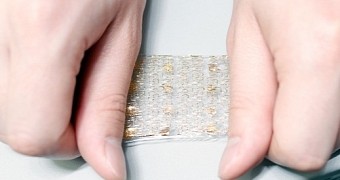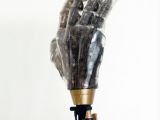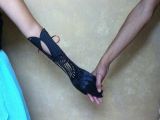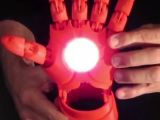One of the many long-standing dreams caused by science fiction is for humankind to be able to restore lost limbs and organs. Another is to make technological replacements. Neither has been achieved, but prosthetics may yet reach that advanced stage in our lifetime.
Not too long ago, an arm was created that can be controlled by the user's mind, owing to it being directly connected to the nerves in the shoulder stump.
The prosthesis wasn't particularly fast, but it did work without the user having to dance in place (foot/leg movements and motion detection are sometimes used to control the grip).
This means that further refinement is the only thing needed for mankind to finally create technological hands like those from Star Wars and any other series depicting an advanced enough civilization.
By extension, other research groups not directly involved with that side of prosthetic limb development can focus on other things, like tactile feedback.
Researchers create skin that behaves like natural one
A group of researchers from South Korea and the United States have developed a polymer that can imitate the elasticity and high sensory capabilities of real skin.
The polymer is infused with a dense network of ultrathin gold and silicon sensors, allowing it to restore sensation normally lost along with a limb or part of it.
Previously, advanced prosthetics used electrodes attached to the nerve of the arm stump in order to receive sensory info (from 20 sensors on the hand), but that only provided part of the sensory info. The user could know if they were holding something soft, for example.
The new skin can do that, as well as detect temperature and grip stability. Pain would probably be within the ability of the sensors to emulate, but who would want that?
Interestingly enough, silicon wouldn't normally be viable for the role given to it here, since it's pretty brittle under normal circumstances. The science team dodged the problem by configuring it in serpentine shapes that can lengthen when the skin stretches.
There are up to 400 sensors per square millimeter, making the skin the most sensitive material ever made by a human or group of humans.
The stretching ranges can even be tuned depending on where they are located on a hand, forearm or any other spot. So you could, say, have the skin set on a prosthetic finger, at which point that finger would suddenly have the tactile sensitivity of a real finger.
How the concept came about
The goal has been around for some time. Materials science experts did much of the rest, with special mention going to the men and women who used motion-capture cameras to study how a real hand moves and stretches. Based on that info, the silicon shapes were chosen and modified for different spots on the prosthetic skin.
At this point, the only thing holding prosthetic designers back is the fact that there are no interfaces capable of relaying to our nervous system everything that the skin can feel. Hopefully, this hurdle will be overcome soon.

 14 DAY TRIAL //
14 DAY TRIAL // 


